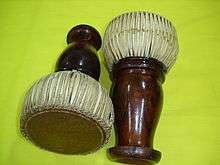Romvong
Romvong (Khmer: រាំវង់, also romanized as Rom vong or Roam vong), Lamvong (Lao: ລຳວົງ - lám wóŋ) or Ramwong (Thai: รำวง), is a type of Southeast Asian dance where both females and males dance in a circle. It is a popular folk-dance in Cambodia, Laos and Thailand. It is a slow round dance continuously moving in a circular manner, and incorporates graceful hand movements and simple footwork. Both men and women participate in the same circle. This dance is still popular at traditional festivities in Khmer, Lao and Thai culture.
Ramvong dance has been performed in Cambodia by Khmers and other ethnic groups such as Phnong, Krung, Tampuan and Prou people. This circular dance style is claimed as a traditional dance in the three countries of the region where it is often part of different types of events and popular celebrations.[1]
Description
The basic pattern involves two couples folding their palms, with their fingers at right angles to their wrists, and bringing the hands up from behind the body to in front of the face, straightening and bending the fingers in time to the music throughout. The hands move in opposition directions - one to the left and one to the right.
The legs must move in time of the rhythm, and in the opposite direction of the partner. Dancers continue around in a circle, keeping in time with the beat of the drum. There is often a decorated pole or a vase of flowers used to mark the center of the circle.
Importance in Thailand

In Thailand ramwong is deemed to have originated in ramthon (Thai: รำโทน), an older kind of folk dance where the rhythm was marked by a kind of drum known as thon (Thai: โทน). The fine arts department of Thailand has identified over ten different styles of ramwong.[2]
Ramwong was patronized by Prime Minister Plaek Phibunsongkhram during the hard times of Thailand in World War II. In order to help people to forget their penury, the military dictator encouraged Thai women and men to enjoy themselves by dancing ramwong. Also, as part of the policy of Thaification during his tenure, Phibunsongkhram aimed to stem the popularity of non-Thai dances such as the foxtrot or waltz through the promotion of ramwong. Even government officials were given half a day during the work week to dance ramwong together at their offices. After the end of World War II ramwong was largely replaced by luk thung and cha-cha-cha although its influence survived in Thai society.[3]
See also
References
External links
- Leisure Cambodia: Popular Khmer Dances
- Photo of ramvong circle (Laos)
- CulturalProfiles.net: "Fon phun muang - Lao folk dance".
- Thai Women: Changing Status and Roles